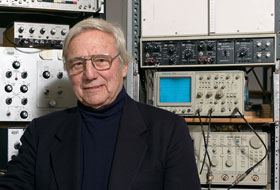  |
| HOME | THIS ISSUE | CALENDAR | GRANTS | BACK ISSUES | < BACK | NEXT > |
Faculty named AAAS fellows for work on molluscs, physicsby Cindy Weiss - December 11, 2006 |
||||||
| Two faculty members in the College of Liberal Arts and Sciences have been elected fellows of the American Association for the Advancement of Science (AAAS). Sandra Shumway, professor- in-residence in the Department of Marine Sciences, and Joseph Budnick, professor emeritus and research professor in physics, join the list of 14 faculty and emeritus faculty members at UConn who are AAAS fellows. They were the only two elected this year. AAAS, which publishes Science magazine, covers all fields of science, and ranges from basic research to the applications of science to society, says William Stwalley, Board of Trustees Distinguished Professor of Physics, who was elected an AAAS fellow last year.
Shumway, who came to UConn five years ago, conducts research on shellfish and harmful algal blooms, known popularly as "red tides." She was cited by AAAS for her work in using flow cytometry to learn more about how molluscs feed, and for documenting the impacts of toxic algae on marine life. In work at the Bigelow Laboratory for Ocean Sciences in Maine in the 1980s, she and colleagues were the first to use a flow cytometer - then a new instrument to marine science - to measure the size, composition, and surface characteristics of the particles on which clams and other molluscs feed. "I literally woke up at 3 a.m. one morning and said, 'I know what we can do with that,'" says Shumway, recalling how the Maine lab was one of the first to obtain the new instrument. Flow cytometry allowed scientists to get a better sense of what feeding molluscs are capable of doing, she says. Oysters, for example, are incredibly efficient at what they choose to eat, as she and colleagues described in a paper published in Nature . This has implications for their nutrition, for restoration efforts, and for aquaculture, in providing food that will be most readily consumed. "How they do it is still a mystery to us," she says. Shumway is working on that problem with J. Evan Ward, an associate professor of marine sciences, whom she calls "the guru of particle selection." "You don't do anything by yourself," she says. "I've had terrific collaborators through the years." Shumway's work on harmful red tides dates back to a 1987 paper, the first to focus on the impact of the toxic tides on marine animals and aquaculture. Algal blooms, which are increasing globally, affect different marine species in different ways, she says. Not all shellfish are affected by a red tide in the same way, and the species of algae in the bloom also vary in toxic impact. Shumway has twice been president of the National Shellfisheries Association. She was a Marshall Scholar, earning her Ph.D. and D.Sc. degrees at the University of Wales, and a Leopold Fellow, holder of a fellowship that trains scientists to open lines of communication with the press and public. She edits the Journal of Shellfish Research and the Journal of Experimental Marine Ecology, and is the founder and co-editor of Harmful Algae.
Joseph Budnick, who retired three years ago but returned to UConn as a research professor in physics, joined UConn in 1974 as head of the physics department, setting up an extensive nuclear magnetic resonance laboratory here. He studies the basic science of the properties of superconductive and magnetic materials. He was cited by the AAAS for his contributions to condensed matter physics and materials science as a scientist, educator, and administrator. With a colleague at North Carolina State University, Budnick was co-developer of the X-Ray Absorption Beam Line X11 at the National Synchrotron Light Source at Brookhaven National Laboratory. The instrument has been used by many scientists, including a number of UConn physicists and Ph.D. students, in carrying out their research. His present research interest is magnetism and superconductivity. With Barrett Wells, associate professor of physics, and colleagues at the Paul-Scherrer Institute in Switzerland, he is studying the role of electronic phase separation in high temperature, superconducting materials. An eventual outcome of this basic research could be a more complete understanding of the mechanism to produce high temperature superconductivity. That could lead to the more efficient transmission of electricity. He has served as chairman of the American Physical Society's Committee on Opportunities in Physics. Shortly after he came to UConn, he started several outreach projects, establishing close ties with the Connecticut Science Teachers Association, and twice hosting the state high school science fair here. He worked with the PerkinElmer Corp. to establish an off-campus program leading to a master's degree in physics with an optics specialty, addressing a shortage of physics-trained workers in the state's optics industry. He also established scientific ties with the United Technologies Research Center, which led to the development of accelerator-based materials science and physics programs. Before coming to UConn, Budnick was program director for solid state and low temperature physics at the National Science Foundation; chairman of the physics department at Fordham; and a project leader at IBM. He has been editor of Physics Letters A and Physics Reports, and received the Alexander von Humboldt Senior U.S. Scientist award. Like Shumway, he emphasizes the collaborative nature of science. He has worked closely with physics faculty members Douglas Pease and William Hynes, among others. "Everything I've done," he says, "has been with my students and faculty colleagues." |
| ADVANCE HOME UCONN HOME |


